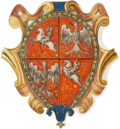| Brochwicz | |
|---|---|
 | |
| Battle cry | Opole |
| Alternative name(s) | Jeleń, Opole |
| Earliest mention | 1268 (seal) |
| Families | names Arndt, Bach, Bornowski, Brochowicki, Brochwicz, Broszkowski, Brygiewicz, Bryszkowski, Bujakowski, Burgrafski, Dobrocieski, Donimirski, Dubaniewski, Falęcki, Foltyński, Gockowski, Goiszewski, Goszczewski, Grabania, Gustkowski, Hotork, Idzik, Kątski, Korczyc, Korczycki, Kleman, Lewiński, Mokrzański, Oreski, Orzelski, Ossowski, Palbicki, Palęcki, Pałęckilink correction, Parasiewicz, Połomski, Potkański, Pruszkowski, Rogoyski, Roik (Brochwicz 3), Sernik, Słoński, Sobek, Sobiewolski, Starorypiński, Stocki, Sulejowski (Sulejewski), Szalowski, Szczucki, Szmakowski, Szydłowski, Szymaniecki, Trawnicki, Trembecki, Wiktor, Witowski, Wojakowski, Worakowski, Wroński, Zakrzewski, Zelewski, Zieliński, Zuchta, Żeromski Contents |
| Gminas | Lublin Voivodeship |
Brochwicz is a Polish coat of arms. It was used by several szlachta families.





